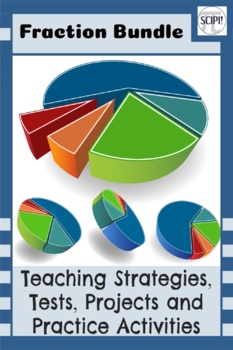Fraction Bundle: Teaching Strategies, Tests, Projects and Practice Activities
- Zip
Products in this Bundle (13)
showing 1-5 of 13 products
Description
This fraction bundle of 13 resources incorporates strategies on how to teach fractions, reduce fractions, work with simple percents, recognize equivalent fractions, find LCM and GCF in addition to adding, subtracting, multiplying and dividing fractions. It contains two EDITABLE projects, four EDITABLE tests, and six fraction word puzzle activities, one crossword puzzle as well as a guideline for teaching fractions using a new approach. All of the resources are aligned with the CCSS standards and follow the Number and Operation Strand for Fractions.
The teaching methods target the kinesthetic learner, the visual/spatial learner, the auditory student, and the student who with a learning disability. The unconventional techniques described in Unlocking Fractions for the Confused and Bewildered will always work. The divisibility rules are included along with Why We Can't Divide by Zero.
Three EDITABLE fraction tests, worth 100 points each, are contained in this 13 item bundle. Each test includes at least one higher thinking level question from Bloom’s as well as application (word) problems. An answer key is included. The two different projects may be given as a final test or as a summative project. The questions use three levels of Bloom’s Taxonomy and encompass the main points of fractions, decimals, and percents. The answer keys and grading rubrics are added for the teacher. None of these six documents are saved in PDF so that the teacher may adapt it as needed.
The six word puzzle activities provide a fun and engaging way to practice reducing fractions to lowest terms, identifying equivalent fractions and recognizing percents. Specific words are given. The students are instructed to figure out the correct fractional part of each particular word. (Example: The first ½ of WEST would be WE. Notice that WE is also 2/4 of WEST.) When each fractional part is correctly identified, a new word is created. Each group of new words becomes a holiday message or riddle. Answers are included.
Included are two free form math crossword puzzles feature 27 different math terms associated with fractions. The objective is to have students practice, review and use correct mathematical vocabulary.
For a specific preview of each resource, click on the desired link below.
Fractions - Teaching Strategies:
Fraction Tests and Projects:
- Fractions: A Cumulative Math Test (all operations)
- Fractions, Decimals and Percents: A Chapter Test
- Fractions: An Introductory Test
- Fraction Summative Assessment with an Ice Cream Theme
- Fraction Summative Project with a Pizza Theme
Fraction Word Activities:
- April Word Fractions
- December Holiday Fraction Riddles
- Halloween Fraction Riddles
- March Fraction Riddles
- Snow Joke: Winter Fraction Riddles
- Valentine Fraction Riddles
Crossword Puzzles





